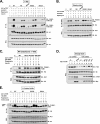mTOR kinase domain phosphorylation promotes mTORC1 signaling, cell growth, and cell cycle progression
- PMID: 21576368
- PMCID: PMC3133410
- DOI: 10.1128/MCB.05437-11
mTOR kinase domain phosphorylation promotes mTORC1 signaling, cell growth, and cell cycle progression
Abstract
The mammalian target of rapamycin complex 1 (mTORC1) functions as an environmental sensor to promote critical cellular processes such as protein synthesis, cell growth, and cell proliferation in response to growth factors and nutrients. While diverse stimuli regulate mTORC1 signaling, the direct molecular mechanisms by which mTORC1 senses and responds to these signals remain poorly defined. Here we investigated the role of mTOR phosphorylation in mTORC1 function. By employing mass spectrometry and phospho-specific antibodies, we demonstrated novel phosphorylation on S2159 and T2164 within the mTOR kinase domain. Mutational analysis of these phosphorylation sites indicates that dual S2159/T2164 phosphorylation cooperatively promotes mTORC1 signaling to S6K1 and 4EBP1. Mechanistically, S2159/T2164 phosphorylation modulates the mTOR-raptor and raptor-PRAS40 interactions and augments mTORC1-associated mTOR S2481 autophosphorylation. Moreover, mTOR S2159/T2164 phosphorylation promotes cell growth and cell cycle progression. We propose a model whereby mTOR kinase domain phosphorylation modulates the interaction of mTOR with regulatory partner proteins and augments intrinsic mTORC1 kinase activity to promote biochemical signaling, cell growth, and cell cycle progression.
Figures








Similar articles
-
Site-specific mTOR phosphorylation promotes mTORC1-mediated signaling and cell growth.Mol Cell Biol. 2009 Aug;29(15):4308-24. doi: 10.1128/MCB.01665-08. Epub 2009 Jun 1. Mol Cell Biol. 2009. PMID: 19487463 Free PMC article.
-
Intestinal cell kinase (ICK) promotes activation of mTOR complex 1 (mTORC1) through phosphorylation of Raptor Thr-908.J Biol Chem. 2012 Apr 6;287(15):12510-9. doi: 10.1074/jbc.M111.302117. Epub 2012 Feb 22. J Biol Chem. 2012. PMID: 22356909 Free PMC article.
-
Regulation of mTOR complex 1 (mTORC1) by raptor Ser863 and multisite phosphorylation.J Biol Chem. 2010 Jan 1;285(1):80-94. doi: 10.1074/jbc.M109.029637. Epub 2009 Oct 28. J Biol Chem. 2010. PMID: 19864431 Free PMC article.
-
Growing knowledge of the mTOR signaling network.Semin Cell Dev Biol. 2014 Dec;36:79-90. doi: 10.1016/j.semcdb.2014.09.011. Epub 2014 Sep 19. Semin Cell Dev Biol. 2014. PMID: 25242279 Free PMC article. Review.
-
Mammalian target of rapamycin: hitting the bull's-eye for neurological disorders.Oxid Med Cell Longev. 2010 Nov-Dec;3(6):374-91. doi: 10.4161/oxim.3.6.14787. Epub 2010 Nov 1. Oxid Med Cell Longev. 2010. PMID: 21307646 Free PMC article. Review.
Cited by
-
Silencing of tuberin enhances photoreceptor survival and function in a preclinical model of retinitis pigmentosa (an american ophthalmological society thesis).Trans Am Ophthalmol Soc. 2014 Jul;112:103-15. Trans Am Ophthalmol Soc. 2014. PMID: 25646031 Free PMC article.
-
The peptide AC 2 isolated from Bacillus-treated Trapa japonica fruit extract rescues DHT (dihydrotestosterone)-treated human dermal papilla cells and mediates mTORC1 signaling for autophagy and apoptosis suppression.Sci Rep. 2019 Nov 15;9(1):16903. doi: 10.1038/s41598-019-53347-3. Sci Rep. 2019. PMID: 31729428 Free PMC article.
-
Immunofluorescence can assess the efficacy of mTOR pathway therapeutic agent Everolimus in breast cancer models.Sci Rep. 2019 Jul 29;9(1):10898. doi: 10.1038/s41598-019-45319-4. Sci Rep. 2019. PMID: 31358767 Free PMC article.
-
TSC loss distorts DNA replication programme and sensitises cells to genotoxic stress.Oncotarget. 2016 Dec 20;7(51):85365-85380. doi: 10.18632/oncotarget.13378. Oncotarget. 2016. PMID: 27863419 Free PMC article.
-
A Tiny Viral Protein, SARS-CoV-2-ORF7b: Functional Molecular Mechanisms.Biomolecules. 2024 Apr 30;14(5):541. doi: 10.3390/biom14050541. Biomolecules. 2024. PMID: 38785948 Free PMC article.
References
-
- Alessi D. R., Pearce L. R., Garcia-Martinez J. M. 2009. New insights into mTOR signaling: mTORC2 and beyond. Sci. Signal. 2:pe27. - PubMed
-
- Avruch J., et al. 2009. Activation of mTORC1 in two steps: Rheb-GTP activation of catalytic function and increased binding of substrates to raptor. Biochem. Soc. Trans. 37:223–226 - PubMed
-
- Bhaskar P. T., Hay N. 2007. The two TORCs and Akt. Dev. Cell 12:487–502 - PubMed
-
- Carriere A., et al. 2008. Oncogenic MAPK signaling stimulates mTORC1 activity by promoting RSK-mediated raptor phosphorylation. Curr. Biol. 18:1269–1277 - PubMed
Publication types
MeSH terms
Substances
Grants and funding
LinkOut - more resources
Full Text Sources
Molecular Biology Databases
Research Materials
Miscellaneous
